Used for finding surface or near surface defects in ferromagnetic material, Magnetic Particle testing is a versatile inspection method used for field and shop applications. Magnetic particle testing works by magnetizing a ferromagnetic specimen using a magnet or special magnetizing equipment. If the specimen has discontinuity, the magnetic field flowing through the specimen is interrupted and leakage field occurs. Finely milled iron particles coated with a dye pigment are applied to the specimen. These are attracted to leakage fields and cluster to form an indication directly over the discontinuity. The indication is visually detected under proper lighting conditions. The basic procedure that is followed to perform magnetic particle testing consist of the following:
Pre-cleaning of component of Magnetic field of magnetic media of magnetic particle indications.
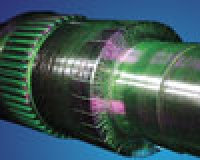 It is essential for the particles to have an unimpeded path for migration to both strong and weak leakage fields. Therefore, the component in question should be clean and dry before beginning the inspection process. The presence of oil, grease or scale may compromise the inspection. The introduction of the magnetic field can be introduced a number of ways including use of a permanent magnet, flowing of electrical current through the specimen or flowing an electrical current through a coil of wire around the part or through a central conductor running near the part. Two types of magnetic fields can be established within the specimen. These are a longitudinal magnetic field that runs parallel to the long axis of the part or a circular magnetic field that runs circumferentially around the perimeter.
It is essential for the particles to have an unimpeded path for migration to both strong and weak leakage fields. Therefore, the component in question should be clean and dry before beginning the inspection process. The presence of oil, grease or scale may compromise the inspection. The introduction of the magnetic field can be introduced a number of ways including use of a permanent magnet, flowing of electrical current through the specimen or flowing an electrical current through a coil of wire around the part or through a central conductor running near the part. Two types of magnetic fields can be established within the specimen. These are a longitudinal magnetic field that runs parallel to the long axis of the part or a circular magnetic field that runs circumferentially around the perimeter. 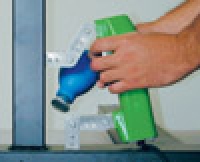 Longitudinal magnetic fields are produced using a magnetic coil or a permanent magnet called a magnetic particle yoke. Circular magnetic fields are produced by passing current through the part or by placing the part in a strong circular magnetic field. Magnetic particle inspection can use either wet or dry magnetic media. The dry method is more portable, while the wet method is generally more sensitive since the liquid carrier gives the magnetic particles additional mobility. A skilled inspector must interpret indications that are formed after applying the magnetic field. This requires the individual to distinguish between relevant and irrelevant indications.
Longitudinal magnetic fields are produced using a magnetic coil or a permanent magnet called a magnetic particle yoke. Circular magnetic fields are produced by passing current through the part or by placing the part in a strong circular magnetic field. Magnetic particle inspection can use either wet or dry magnetic media. The dry method is more portable, while the wet method is generally more sensitive since the liquid carrier gives the magnetic particles additional mobility. A skilled inspector must interpret indications that are formed after applying the magnetic field. This requires the individual to distinguish between relevant and irrelevant indications.
The following are the advantages of magnetic particle inspection:
|
|
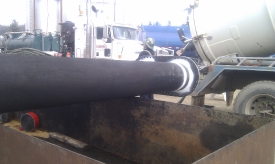 |
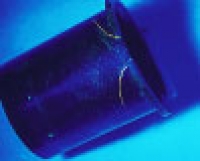 |
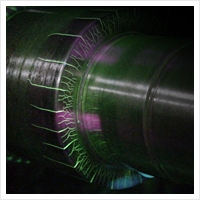 |
Dry Particle Inspection in this magnetic particle testing technique, dry particles are dusted onto the surface of the test object as the item is magnetized. Dry particle inspection is well suited for the inspections conducted on rough surfaces. When an electromagnetic yoke is used, the AC or half wave DC current creates a pulsating magnetic field that provides mobility to the powder. The primary applications for dry powders are unground welds and rough as-cast surfaces.
Dry particle inspection is also used to detect shallow subsurface cracks. Dry particles with half wave DC are the best approach when inspecting for lack of root penetration in welds of thin materials. Half wave DC with prods and dries particles is commonly used when inspecting large castings for hot tears and cracks.
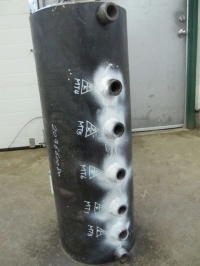 Wet Suspension Inspection
Wet Suspension Inspection
Wet suspension magnetic particle inspection, more commonly known as wet magnetic particle inspection, involves applying the particles while they are suspended in a liquid carrier. Wet magnetic particle inspection is most commonly performed using a stationary, wet, horizontal inspection unit but suspensions are also available in spray cans for use with an electromagnetic yoke. A wet inspection has several advantages over a dry inspection. First, all of the surfaces of the component can be quickly and easily covered with a relatively uniform layer of particles. Second, the liquid carrier provides mobility to the particles for an extended period of time, which allows enough particles to float to small leakage fields to form a visible indication. Therefore, wet inspection is considered best for detecting very small discontinuities on smooth surfaces. 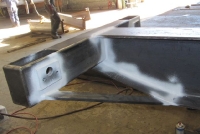 On rough surfaces, however, the particles (which are much smaller in wet suspensions) can settle in the surface valleys and lose mobility, rendering them less effective than dry powders under these conditions.
On rough surfaces, however, the particles (which are much smaller in wet suspensions) can settle in the surface valleys and lose mobility, rendering them less effective than dry powders under these conditions.
MPT Fluorescent Fluorescent Magnetic Particles (requires a black light) are used in the detection of SURFACE and SUBSURFACE indications in FERROUS materials. Each product can be used for either WET or DRY methods of magnetic particle inspections. Particle size is controlled to ensure maximum sensitivity. Meets major specifications. Provides accurate, reliable crack detection results in the following applications:
|
|
|
MPT Visual Visible (day light) Magnetic Particles are used for magnetic particle inspection method in the detection of SURFACE and SUBSURFACE indications in FERROUS materials. Each product can be used for either WET or DRY methods of magnetic particle inspections. Particle size is controlled to ensure maximum sensitivity. Meets major specifications. Provides accurate, reliable crack detection results in the following applications:
|
|
|
